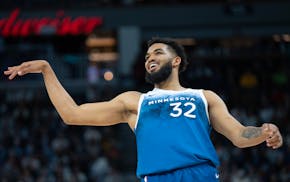The on-air talent for Fox Sports North turned it into a cliché on Twins telecasts: Here comes Joe Nathan, the best closer in baseball.
On the occasion of a Nathan gaffe, we would be reminded that this was a rarity and then receive reassurance of his standing as the game's best.
Why our TV experts felt the need to voice that superlative was anybody's guess, when you consider baseball men such as Bert Blyleven and Ron Coomer realized that could not be the case ... not as long as Mariano Rivera still was finishing games for the Yankees.
The difference between Nathan, an effective closer, and Rivera, the all-time great, has been best demonstrated in the postseason: Nathan has pitched in eight games with a 7.88 ERA and two losses. Rivera has pitched in 88 games with an 0.74 ERA and one loss.
The other contrast has been the manner in which managers have used Nathan and Rivera in late-season games.
Ron Gardenhire basically avoided turning to Nathan for more than three outs, even in a must-win game. Joe Torre, during his long run as the Yankees manager, never hesitated in bringing in Rivera for six outs when ahead in a game he needed.
There was a time when I was among the foolish sold on the idea that a closer was the most valuable member of a pitching staff. This probably is based on a flashback to 1982 through 1985, when Ron Davis served in that role for the Twins.
Davis had more calamities than any human should undertake, but in retrospect, he was never used with the TLC that Twins closers have received first from Tom Kelly and now Gardenhire.
For instance: Davis was asked by manager Billy Gardner to work 106 innings in 63 appearances in 1982 -- a time when the pitchers assigned to finish games were referred to as "stoppers" and routinely required to get six outs for a save.
Oakland manager Tony La Russa created the "closer" model in 1987, when he started holding back Dennis Eckersley for ninth innings and three outs.
Davis had 30 saves in 66 appearances and pitched 89 innings in 1983. That's 17 innings more than Nathan ever was asked to pitch in his six seasons as the Twins' closer.
We probably would remember our pal R.D. more kindly if he had been asked to get no more than three outs -- and often with a multi-run lead -- in 95 percent of his save opportunities.
The Twins brought in the hard-nosed Jeff Reardon to finish games in '87, and he had much to do with the Twins' first World Series championship. You can see a different theory for the finisher in that postseason:
Reardon entered three times in the eighth inning of the five-game ALCS against Detroit and once in the seventh inning in the World Series against St. Louis.
Last October, the Twins held a 3-1 lead entering the bottom of the eighth in Game 2 against the Yankees. Gardenhire still went with Matt Guerrier, reserving Nathan for the ninth, when a potential three-out save turned to disaster.
Kelly went more to the Eckersley model with Reardon in 1989, and the Twins have done it that way since. Rick Aguilera, Eddie Guardado and Nathan closed successfully in 16 of the previous 20 seasons and seldom were asked to get more than three outs.
Twice in short order last summer, Nathan was getting warm and the Twins rallied to push the lead past three runs. Nathan was allowed to stay in the bullpen as another reliever entered and wound up creating a stats-building save situation for him.
It was at that point I reached the conclusion that being a Twins closer is among the most-pampered positions in baseball.
There are the dozen saves that must be ground out with a small lead against the heart of an order -- as was the case with Jon Rauch, Nathan's replacement, on Tuesday night in Detroit.
And there are the other 30 where it takes a full-esophagus choke to let a victory get away.
Keep throwing strikes, Mr. Rauch. The manner in which the Twins coddle their closer makes that good enough most of the time.
Patrick Reusse can be heard noon-4 weekdays on AM-1500 KSTP • preusse@startribune.com

Reusse: Taylor's story. 'I just bought the Minnesota Timberwolves.'

Reusse: Back from injury, Towns doesn't have to carry load


